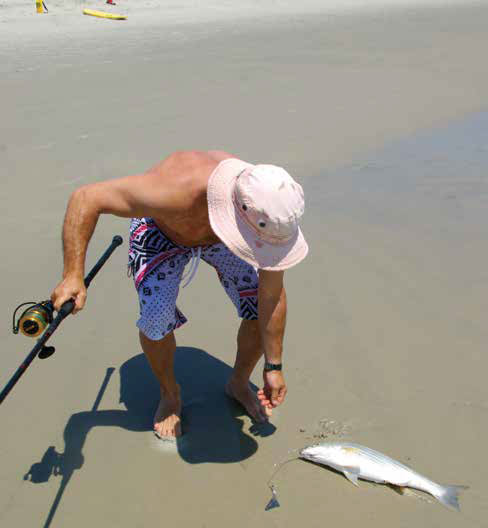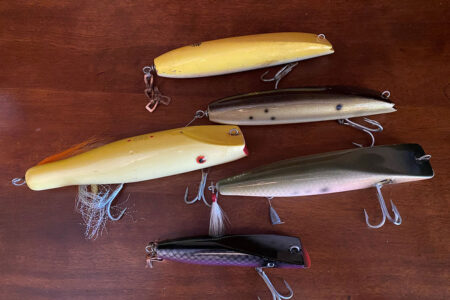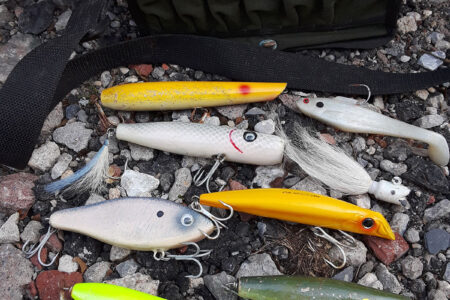
Short on buggy options for the summer, the options come down to “walking” or staying put.
Surf fishing is all about making choices and mastering challenges in the quest to catch fish. How you choose to fish the surf is critical to your success. During the summer surf sessions, your choices boil down to two basic styles: traveling light and walking long stretches of shoreline, or bringing more gear and working a given stretch of beach intensively.
Each technique has its advantages and disadvantages. Often your choice is made by personal preference; sometimes dictated by the targeted species; and usually by the stage of the fishing season.
Travel Light
Walking a shoreline using a “walk, cast, retrieve, walk” routine is a great way to probe ever-changing underwater terrain for holes, cuts, troughs and bars that serve as natural ambush spots for striped bass, bluefish, fluke and other species. It is also an effective tactic to locate and probe pockets of baitfish located along a long stretch of shoreline. Having the mobility that this system offers enables you to move quickly to wherever you see fish blasting baitfish.
This technique is used almost exclusively when using lures for striped bass and bluefish although it works wonders when targeting fluke with bucktails or rigs tipped with manufactured bait like Gulp! swimming mullet.

Those surfcasters who like to walk a shoreline usually travel light, with a lightweight but strong rod and reel combo together with a minimum of lures and other gear. A small surf bag is ideal for this type of fishing. Changing lures often to get a variety of shapes, sizes and colors into the mix is a time-tested tactic. The same goes for artificial baits used for fluke during the summer months: mix up your offerings with different colors and somewhat different profiles.
Traveling light, walking along a shoreline, and tossing lures along the way has many advantages. It is based on proven results, gives you the mobility to move quickly should a feeding flurry erupt near you, and increases your odds of hooking up – day and night – with a variety of gamefish. However, mobility comes at a price. You have to limit your gear to an absolute minimum; whatever you choose, you have to carry. This translates into using a smaller surf bag holding fewer lures and options; the inability to carry a cell phone and camera; being limited to a single rod-and-reel combo; and traveling without incidentals like binoculars, food treats, and water.
Also, not every angler is physically able to walk long distances in soft sand especially in cold weather when waders are a necessity.

Bucket Brigade
There is another style of fishing; setting up camp on some promising stretch of shoreline is popular with both elite and novice anglers. The most essential element in opting for this style is to decide which areas have the best chances of producing fish. Once potential sites have been determined, you can target them when conditions are right.

Working a designated stretch of surf thoroughly has many advantages. Many like doing so because they can be with their friends, or by themselves. They can bring a lot more gear to the site than if they were walking a shoreline; it is also much less physically taxing than walking, stopping, cast and retrieving, and walking again – often through soft sand. Generally, anglers who intend to spend much more time fishing choose this style of fishing over the traveling method.
When you stake out a stretch of shoreline and intend to work it thoroughly, you are not just relegated to fishing the water right in front of you. And you are not limited to just fishing bait. When you have friends nearby who can keep an eye on your gear, you can walk the water’s edge north and south of your chosen location to give your lures some great exposure.
Generally, your time on the beach with this style of fishing is much more comfortable than continually moving along the shoreline. You can lug more gear onto the beach: two rod combos instead of just one; sand spikes; a lure bag; an accessory bag with food, water, and a spare hooded-sweatshirt; and a chair even if it is only a bucket. You can share the excitement of landing a nice fish with your friends, or vent with them about how bad the fishing is.
These two distinct systems each have their advantages and advocates. Which of these two styles has your DNA all over it? Or do you hedge your bets preferring a hybrid approach: sometimes opting for the mobile route while at other times planting yourself in a designated area and exploring it intensively? You cannot make a bad choice.



